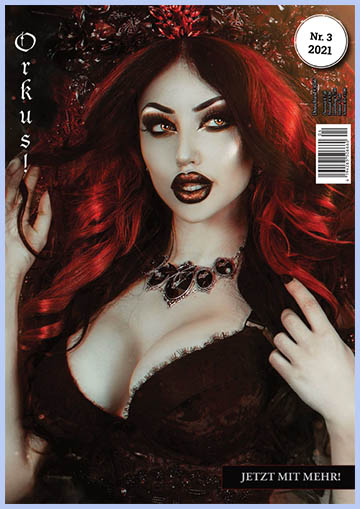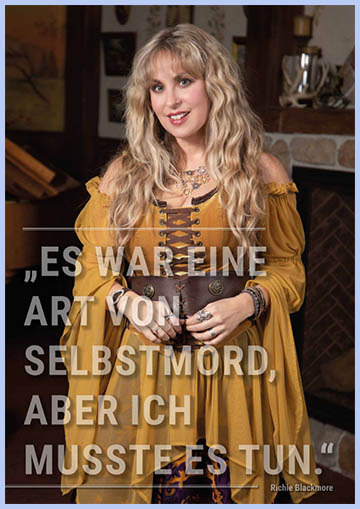|
Blackmore's Night It was some kind of suicide, but I had to do it.  The earthy, organic sound of Blackmore's Night became always inspired by nature. With "Nature's Light" the Mother Nature couple created a wonderful album that musically the bridge from the late Middle Ages to the Renaissance to the present suggests. The cover picture (painted by her eight-year-old son) shows a sun: "I loved her Idea of the simplicity of the rising sun," explains Ritchie Blackmore and continues, "As far as we know, the sun will always rise ..." About the addiction to ancient music, incredible self-taught skills and old locks.
The earthy, organic sound of Blackmore's Night became always inspired by nature. With "Nature's Light" the Mother Nature couple created a wonderful album that musically the bridge from the late Middle Ages to the Renaissance to the present suggests. The cover picture (painted by her eight-year-old son) shows a sun: "I loved her Idea of the simplicity of the rising sun," explains Ritchie Blackmore and continues, "As far as we know, the sun will always rise ..." About the addiction to ancient music, incredible self-taught skills and old locks.Ritchie Blackmore sees himself "like a wandering minstrel. Above all, I make the most of it with the music of the Renaissance period around 1500. Candice on the other hand, is more into modern music today. She also listens to the radio while I never do." Candice Night grins and nods knowingly, and so it is it that gives the sound a modern touch in the right place. For his Gibson Ritchie feels according to his own statements too old, he has changed it against a Fender Stratocaster. "I'm having fun about playing rock and rocking out, but my heart has been beating for a good 20 years now to the rhythm of the Renaissance era," he confirms. How could it for that founding member of Deep Purple actually come about in a U-turn? Ritchie laughs: "My father said to me: 'Don't you think it's a bit risky to go to renaissance music if you are actually known for rock'n'roll?' I said: 'I don't think so, I know that!' It was kind of suicide, but I had to do it." Ritchie recalls that it was the "drug of Renaissance music", like he already describes his love for this musical era when he was ten. It was an interpretation of "Greensleeves" that made him sit up and take notice. "And then, in 1972, I heard David Munrow in the Early Music Consort of London as he played Tielman Susato, who is a very famous composer from around 1500, called a thing "Danseryes," and that convinced me. After that all I did after my shows with Deep Purple and Rainbow was: I left back to the hotel and played renaissance music. Often times, people from the neighboring rooms complained, but that's how it started," he smiles. But wait a minute, too old to rock? Certainly not: "He often just sits there and plays guitar, whether he's outside on the terrace watching the birds and the water or sitting inside on the couch in front of the fireplace. He is always, always playing. He just makes up incredible melodies and then I am mostly close by when I'm not out and about with the kids. So he often calls me and says, 'I have this idea, here is a melody line. Just hum along and let's see if it works,' says Candice and continues: "I then just absorb them. His melodies are always like that to me visually, even if it's just instrumental pieces. I close my eyes and paint pictures in my head what the melody is about want. It is that what determines where to go." The album title came naturally: "Every picture, that we saw was so illuminated and inspiring that nature in itself the magic or the light of nature", confirms Candice. Being close to nature means for Blackmore's Night also becoming one with the Elements: "We feel connected with the earth, the fire, water, the air, the moon, and the sun. All of this works again back to the light of nature", explains Candice.  This is also shown in the cover song by Sarah Brightman and Frank Peterson. As Candice "Second Element" first heard, she fell in love and got into it immediately. It's a love song to the water, the source of all life and so the circle closes wonderfully on the overall theme of the album. "I feel like we're more than ever going into nature, probably to find more inspiration to do that escape what is happening in our world today." By that, Candice means, of course the pandemic that has held us in a stranglehold for a year.
This is also shown in the cover song by Sarah Brightman and Frank Peterson. As Candice "Second Element" first heard, she fell in love and got into it immediately. It's a love song to the water, the source of all life and so the circle closes wonderfully on the overall theme of the album. "I feel like we're more than ever going into nature, probably to find more inspiration to do that escape what is happening in our world today." By that, Candice means, of course the pandemic that has held us in a stranglehold for a year.Don't you miss touring at all? Ritchie less, he's been touring too often in his life, but slowly he's burning again under the fingernails. Live streams (the Blackmore's Night last year too) are ultimately no substitute for real concerts, in which people connect with each other. He feels this connection more at concerts on a small scale, because "we then become a community celebrating an exuberant party together." Candice also misses the spectacular backdrops in which Blackmore's Night has always were allowed to play in the past: "There is nothing better than to appear in a castle! I wonder which stories these ancient walls in the course of the centuries could tell. Of course you can google all this stuff too, but to lay hands on the stone foundations and to feel the energy is like nothing compared." And that, in turn, is often one source of inspiration for later compositions. A real castles and palaces expert turns out to be Ritchie, who has always had a fascination for this. "For many, many years he has been reading everything about it and informs himself very precisely. As far as I can remember, he went to them often when touring with Deep Purple, they stayed in bigger cities and he has took his personal roadie with him and went out in the country. They drove for miles to a castle and stayed there all alone away from the rest of the band that stayed in town in a modern hotel with room service," tells Candice about her husband. "I'm downright obsessed with locks", he confirms and also emphasizes the special resonance of a castle that makes a special sound. While Ritchie is undoubtedly an unmatched virtuoso on guitar, he in turn is fascinated by the musicality of his charming wife: "She plays all these instruments: crooks, shawms, smoking pipes ... And she never took lessons which I find very bizarre. She knows intuitive how to play them, to me that remains a mystery to this day. How the hell do you know that?” Candice smiles modestly: "I don't know, I do teach myself, I get the feel myself slowly and then it works." © Claudia Zinn-Zinnenburg - Orkus! no 3, 2021 |